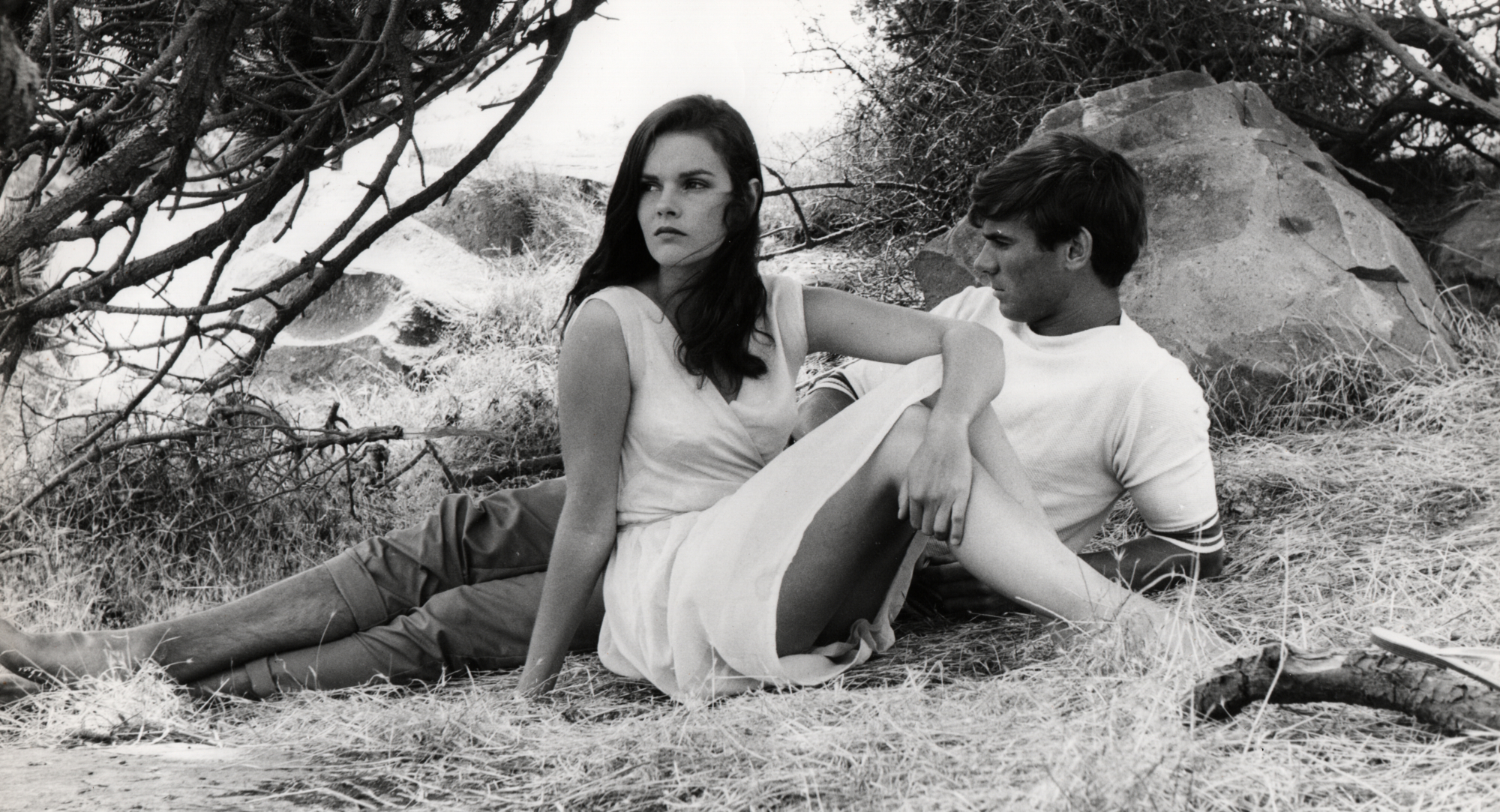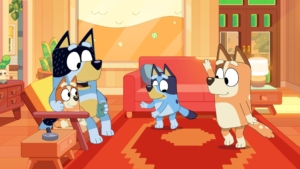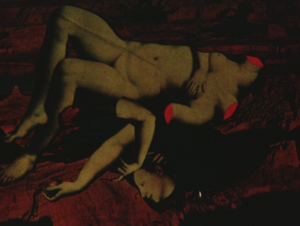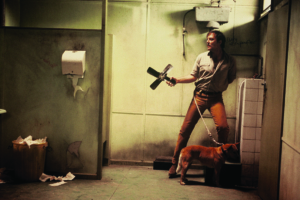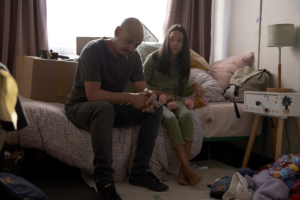Midway through Time in Summer (Ludwik Dutkiewicz, 1968), a ballerina dances alone on stage to a thunderous classical piano piece. She is not one of the numerous women we have previously seen in the film, and even here is barely visible; we merely glimpse her figure within a flickering iris shot, which is superimposed over an image of trees reflected in rippling water. It is as if she has been transported from a silent movie, and in a different realm entirely from the male audience member whose attentive gaze we see in close-up.
As he watches, the stage makes way for a forest, from whose branches emerge a ghostly, dark-haired woman in a black catsuit, extending her hands suggestively, gesturing at something beyond the screen. The performance ends and the man enthusiastically applauds; but as he claps, a shadow descends over his face, the applause fades out and the shot cuts enigmatically – even menacingly – to the auditorium’s concrete exterior.
This unsettling sequence, complete with its eerie, white-noise-imbued soundscape, would not be out of place in a cinematic masterwork like Last Year at Marienbad (Alain Resnais, 1961), Persona (Ingmar Bergman, 1966) or Mulholland Drive (David Lynch, 2001). Yet it belongs instead to a long-forgotten Australian film of the late 1960s, an ill-fitting entry within a national cinema that has rarely had use for the oneiric or the aggressively surreal.
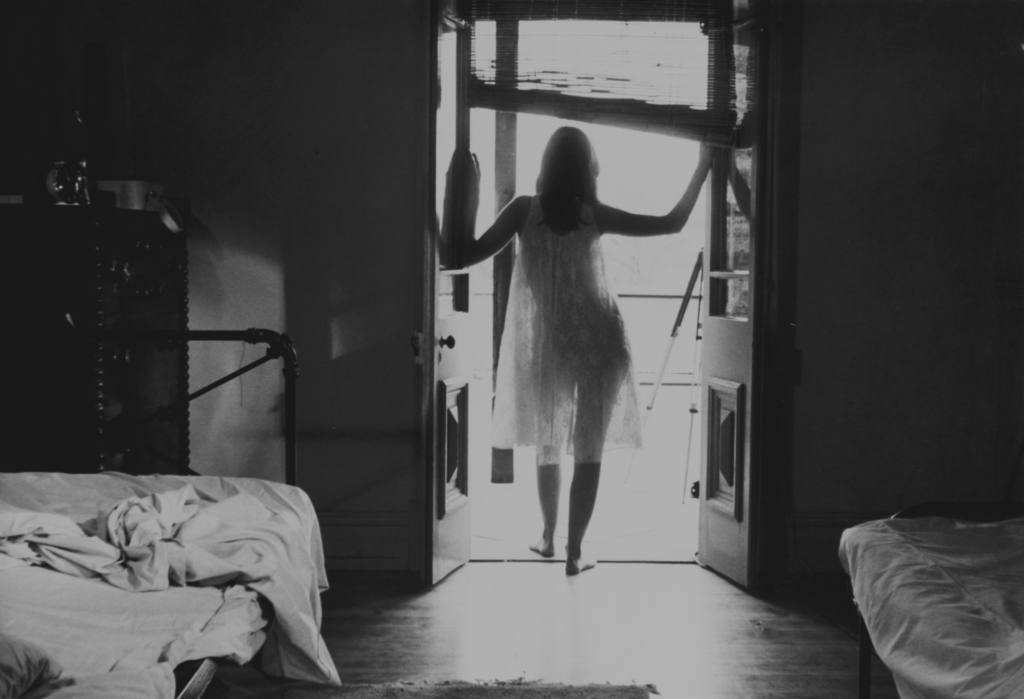
Of course, when Time in Summer emerged in 1968 – screening to packed-out sessions at the Adelaide Festival of Arts before landing a berth at the Berlin Film Festival[1]Time in Summer was screened as part of a strand showcasing work from less cinematically established nations, known as Filmschau der Länder, or Film Show of the Countries. It appears that the only impediment to the film being selected for the official competition was the lateness of its submission: in a letter to executive producer Bryan Glennon on 7 June 1968, festival director Alfred Bauer stated that the selection committee ‘was very much impressed by the film and considers it a very fine production’ but were unable to include it in the competition ‘because the completed print had arrived a little late’. He nonetheless encouraged Glennon to submit the film in the sidebar and invited him, Dutkiewicz and the three main cast members to attend the festival (only O’Brien and Glennon ended up making the trip). Alfred Bauer, letter to Bryan Glennon, 7 June 1968. – there was little national cinema here to speak of. These were years when the Australian film industry, having petered out in the mid-to-late 1950s, lay all but dormant: long past the glory days of the silent and early sound eras, yet still not quite on the verge of its 1970s resuscitation. While the odd internationally funded production made use of Australian landscapes, cast and crew, locally made feature films were rarely sighted between 1958 and 1969. Indeed, the Cannes Film Festival–programmed Clay (Giorgio Mangiamele, 1965)[2]For more on Clay and the work of Mangiamele, see Gino Moliterno, ‘Giorgio Mangiamele: Visionary of the Australian Screen’, Metro, no. 170, Spring 2011, pp. 74–9. and the perhaps even more obscure hour-long Tasmanian children’s adventure movie They Found a Cave (Andrew Steane, 1962) were the only two other wholly Australian-funded features completed and shown in the decade prior to Time in Summer’s appearance.
The film’s near complete erasure from the story of Australian cinema remains remarkable: it appears to have only been publicly screened once since the late 1960s, and has never been substantially critically addressed.
This both points to the film’s historical importance and goes some way to explaining how it has so completely dropped off the map. While there was certainly a hunger for a resurgent Australian cinema at the time,[3]For more on this, see Peter Galvin, ‘At the Threshold of Revival: Australian Cinema and the Moment of 2000 Weeks’, Metro, no. 209, 2021, pp. 102–9 a self-funded, defiantly avant-garde[4]Space does not permit a thorough overview of the history of Australian avant-garde filmmaking in this article, but suffice it to say the movement was still in its early stages in the 1960s, and mostly concentrated around Sydney’s Ubu Films collective. A key member of that group, Albie Thoms, describes Davidson and Dutkiewicz, along with Stan Ostoja-Kotkowski and Frank Eidlitz, as ‘the major avant-garde filmers outside the Ubu group in the mid-60s’. That these pioneering directors were mostly central or eastern European immigrants is surely no coincidence, and worthy of further discussion. See Thoms, ‘The Australian Avant-Garde’, in Albert Moran & Tom O’Regan, An Australian Film Reader, Currency Press, Paddington, NSW, 1985, p. 286. work was always going to be a hard sell. Indeed, Time in Summer is a film that is near impenetrable on first viewing – and, it must be said, not without its share of flaws. But even given all this, the film’s near complete erasure from the story of Australian cinema remains remarkable: it appears to have only been publicly screened once since the late 1960s,[5]Time in Summer’s most recent public screening, to this writer’s knowledge, was in June 1998 at a one-off event in Adelaide organised by Sydney Film Festival founder David Donaldson and the South Australian Media Resource Centre. Another recorded programming of the film was in Sydney at a series of screenings run by Ubu Films in April 1969; publicity material for the event talked up the film’s importance as a rare Australian-produced feature, and noted that it had been overlooked for commercial distribution. See Peter Mudie, Ubu Films: Sydney Underground Movies 1965–1970, University of New South Wales Press, Sydney, 1997, p. 186. and, aside from some contemporaneous reviews and the odd brief summary in Australian film encyclopaedias,[6]The film is given a single page in each of Australian Film: 1900–1977: A Guide to Feature Film Production and The Oxford Companion to Australian Film. See Andrew Pike & Ross Cooper, ‘Time in Summer’, in Pike & Cooper, Australian Film: 1900–1977: A Guide to Feature Film Production, rev. edn, Oxford University Press, South Melbourne, Vic., 1998 [1980], p. 240; and Ben Goldsmith, ‘Time in Summer’, in Brian McFarlane, Geoff Mayer & Ina Bertrand (eds), The Oxford Companion to Australian Film, Oxford University Press, South Melbourne, Vic., 1999, p. 497. has never been substantially critically addressed.
For that to be possible, it is crucial to first get a grasp on the specific context Time in Summer emerged from, and the strands that hold its dense web of images and associations together.
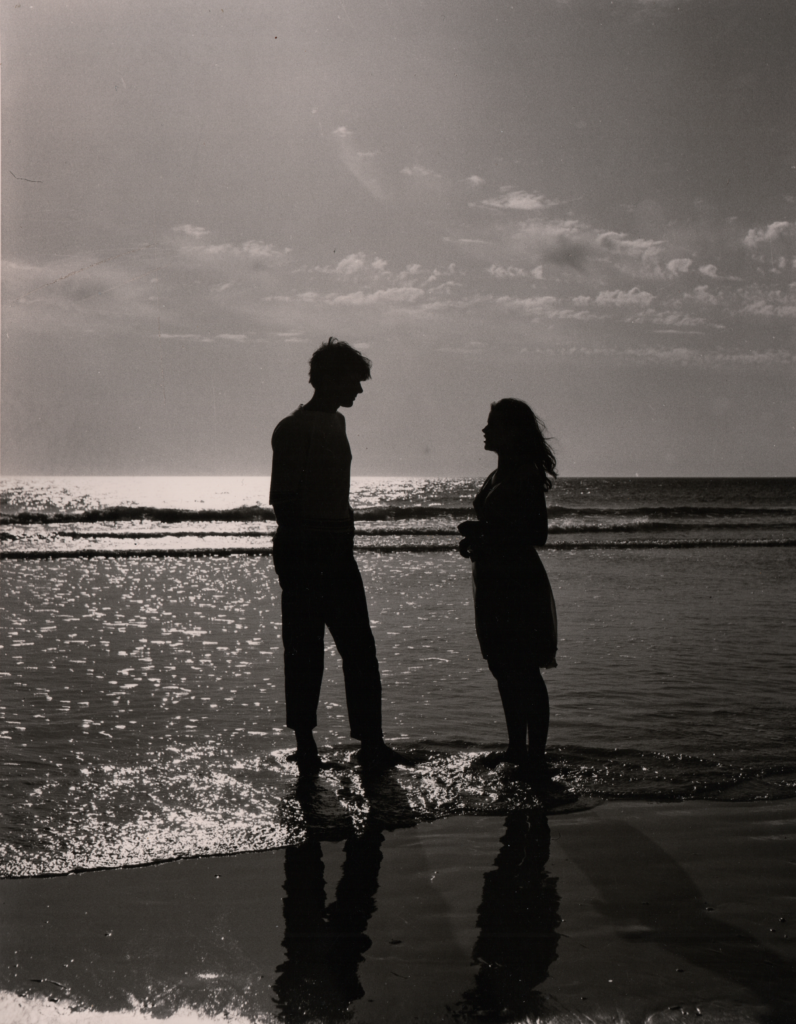
Early collaborations
Time in Summer is a film that resists reductive auteurist categorisations. Its chief author – at least as much as its credited director, if not considerably more so – was cinematographer Ian Davidson, who also scripted and produced the film.[7]This is reflected in the opening credits, which give Davidson the credit for Time in Summer’s ‘film form’.
Born in Adelaide in 1928, Davidson was an ambitious still photographer and sometime medical student who turned to filmmaking in the 1950s after having worked in newsreels.[8]See Tony Love, ‘Hooked on Photography’, The Advertiser, 14 October 2000, p. 70. His first film credits were collaborations with the Polish-Australian artist Stan Ostoja-Kotkowski;[9]See Ian Davidson, Art, Theatre and Photography: Remembering Stan Ostoja-Kotkowski (1922–1994), self-published manuscript, Adelaide, 1999. together, they made a series of experimental shorts in the mid 1950s, including The Quest of Time … (Ostoja-Kotkowski, 1956) and Four Movements (Ostoja-Kotkowski, 1956), which Davidson describes as collectively consisting of ‘purely spontaneous imagery’.[10]Ian Davidson, quoted in Arthur Cantrill, ‘Adelaide – Experimental Film in the 1950s and ’60s’, Cantrills Filmnotes, nos 81/82, June 1996, p. 54. He would later go on to collaborate with directors such as Gerald Turney-Smith and Paul Cox, but his most significant work was with another Polish immigrant, Ludwik Dutkiewicz, with whom he completed two short films and one feature.
Dutkiewicz was born in the village of Stara Sil – then within Polish borders, but today located in far-western Ukraine – on 2 February 1921, and subsequently spent his young adulthood at an art school in Lviv.[11]Adam Dutkiewicz, Ludwik Dutkiewicz: Adventures in Art – Paintings, Graphics, Photographs & Films, Moon Arrow Press, Norwood, SA, 2009, p. 18. Captured by the Nazis during World War II and spending some months in a concentration camp (followed by four years in a refugee camp in the western half of the newly partitioned Germany), he and his brother Wladyslaw subsequently migrated to Australia in 1949, where they quickly became part of Adelaide’s theatre and visual art scene. To this day, the brothers are most well known for their constructivist painting – radical abstract compositions that Wladyslaw’s son, art historian Adam Dutkiewicz, has described as ‘some of the most adventurous of the mid-century period in Australian modernism’.[12]ibid., p. 24. They were among a number of migrant European artists who settled in Adelaide after World War II, including Ostoja-Kotkowski and another of Davidson’s collaborators, the Czech-born animator Dušan Marek. (Marek also produced some important work in this period, including the surrealist 1967 live-action feature Cobweb on a Parachute, which was completed and expected to screen at Cannes but never released due to a dispute with the laboratory handling the film print.[13]Davidson refers to the non-release of Cobweb on a Parachute as ‘a tragedy’, and states that, had the film been shown, ‘it would have put Australia uniquely on the map of world film-makers’. Ian Davidson, ‘Influences in My Life’, document held at the University of Adelaide, 26 June 2000, p. 7.)
Davidson and Dutkiewicz began their artistic partnership in 1960, and subsequently formed the production company Arkaba Films, named for a span of hills in the Flinders Ranges. Their first realised work, the fourteen-minute short Reflections (Dutkiewicz, 1962), was completed soon after. A sophisticated piece of filmmaking, this short is built around a simple device: a young woman, Andrea (Andrea Adams), falls asleep on a train, has a dream of finding and entering an old house in the country with a man (Ron Dix) who describes the experience in voiceover in a matter-of-fact tone, and then is shaken awake in her seat; once she disembarks, the events of the dream are replayed shot for shot, and she narrates her movements in voiceover. The influence of Meshes of the Afternoon (Maya Deren & Alexander Hammid, 1943) is already readily apparent in the film’s symbolic imagery: hands, doorhandles and mirrors abound; in the final sequence, Andrea repeats her dreamed gesture of staring unhappily into a bedroom looking glass, only this time smashes it, glancing back at her splintered reflection as she is embraced by her lover.
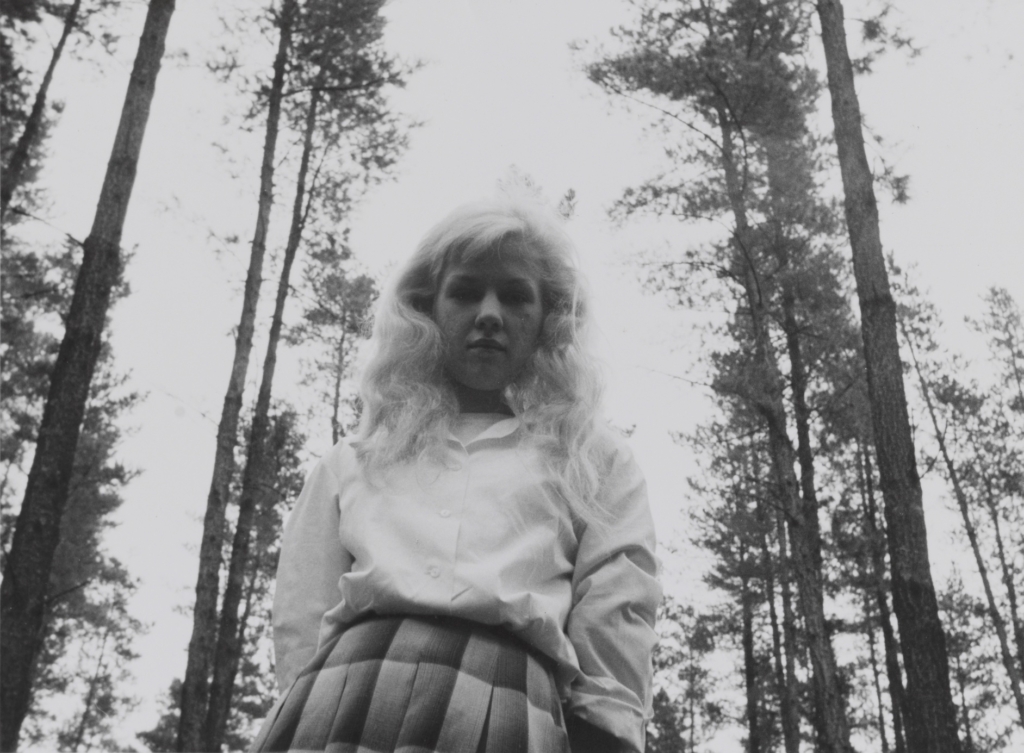
Reflections was beset with technical issues related to its sound synchronisation, and was passed over for a Sydney Film Festival berth.[14]David Donaldson, notes from interview with Ian Davidson, 1997. It was instead the duo’s comparatively slight but no less rigorously composed follow-up, Transfiguration (Dutkiewicz, 1964), that first brought critical attention to their work. The four-minute short, set to Anton Bruckner’s Symphony No. 9 in D Minor, is again situated in the realm of dreams, showing a young woman (Josephine Heysen) alternately lying in bed and traipsing through a moonlit forest. Its formal radicalism lies in its ‘metric montage’, which was, according to Davidson, based on the Fibonacci sequence.[15]Davidson, quoted in Cantrill, op. cit., p. 55. The film’s structure was also informed by the work of pioneering experimental filmmaker Sergei Eisenstein – ‘not following his style’, Ludwik Dutkiewicz notes, ‘but starting from his basic principles’.[16]Ludwik Dutkiewicz, quoted in ‘Film Prize Is Boost to “School”’, The Advertiser, 18 May 1966, cited in Adam Dutkiewicz, op. cit., p. 58.
Transfiguration was a success in its day, screening in competition at Locarno Film Festival and going on to receive the Kodak Award for Best Black and White Photography at the 1964 Australian Film Institute Awards along with a Special Mention for Editing and Camerawork. Its significance in the context of the then-slumbering Australian film industry did not go unnoticed in the press; the film was described in The Advertiser, for instance, as ‘the first big step towards establishing a South Australian “school” of cinematography’.[17]‘Film Prize Is Boost to “School”’, ibid. Today, the film is held within the collection of the Museum of Modern Art in New York, and, while nobody could describe it as being widely seen, it has been by far Dutkiewicz and Davidson’s most visible and available work in the ensuing years.[18]See Cheryl Hoskin, ‘Biographical Note’, in ‘Ludwik Dutkiewicz (1921–2008): Papers’, November 2020, <https://www.adelaide.edu.au/library/special/mss/dutkiewicz/>, accessed 30 May 2022.
Time in Summer, their first and only feature, emerged from two scripts prepared by Davidson: the first, The Man from Elton, dealt with a dying man’s dreams; and the second, Summer Sand, narrated a teenage girl’s coming-of-age story. Shooting for the latter narrative began in February 1965, and continued until the end of that year. Drawing in the brother’s story along with other odds and ends shot over the previous half-a-decade, Davidson then spent a further two years working on the film’s final cut, which was completed in late 1967 in preparation for its Adelaide Festival of Arts premiere on 17 March 1968.[19]Davidson, ‘Influences in My Life’, op. cit., p. 6.
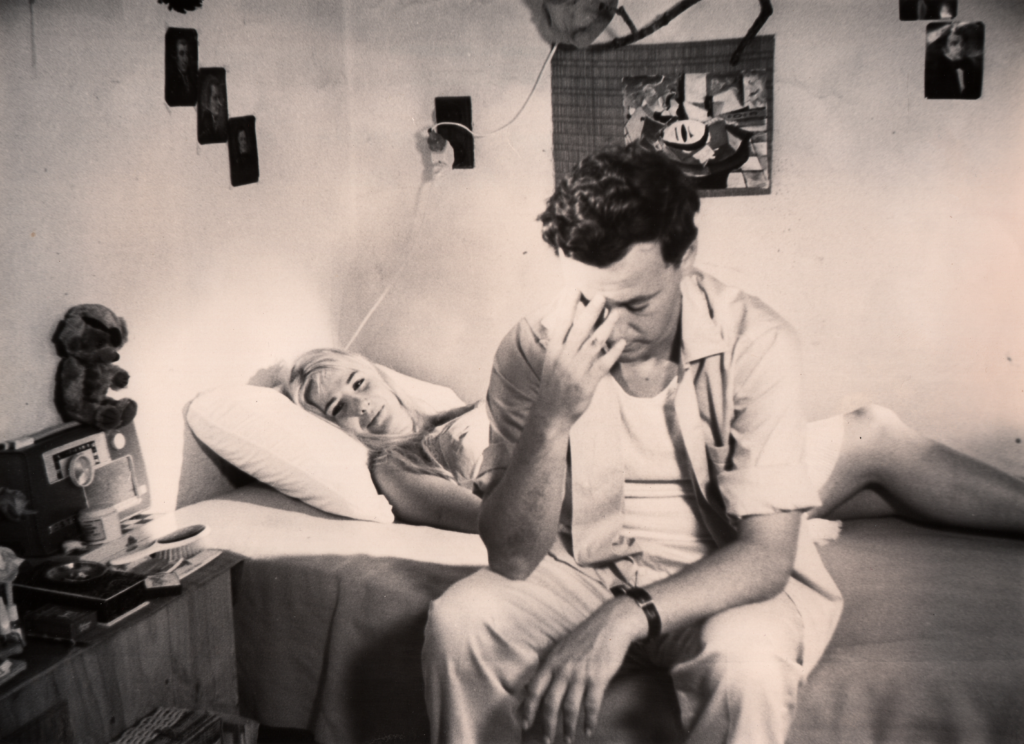
Intersecting pathways
Peter has been out at a party all night. This morning, I got up early and went down to the valley. There was not a sign of human life, so nature still ruled the world.[20]Anne’s opening monologue, heard over a close-up of her hand writing the same words in a diary.
Time in Summer consists of two parallel narratives. One is the story of Peter (Peter Ross), a dour ladies’ man who is dreaming of various entanglements with women after a serious car accident puts him in a coma; the other is the coming-of-age story of his sister, Anne (Christina O’Brien), who becomes fixated on a mysterious young man.
Staying at a holiday house in Victor Harbor with her friend Helena (Gillian Young) over the summer, Anne spends her days sunbathing on the beach. One morning, she idly watches Shawn (Rory Hume) and a couple of male friends playing in the water, while a fortysomething woman, Mrs Harper (Andrena Gwynne-Jones), sits impassively on the sand nearby. Intrigued by their non-interaction – Mrs Harper has been seen with Shawn the previous night, but they now appear to be ignoring each other – Anne and an unwilling Helena begin trailing the boys.
The next morning, Anne impulsively decides to take a nude swim at dawn, during which she is startled to find Shawn hiding in the water; they have a brief, awkward conversation before he sprints off. From here, various enigmatic events occur: Anne follows the boys to a nearby shack, where she witnesses them fighting over a strange camera-like contraption that emits a laser beam; a distraught young woman, Janet (Susan Tipping), accosts the boys at the beach, threatening to drown herself; and the boys attend a harness race, using the laser to cause a horse to stumble. Finally, after another confrontation at the house, Shawn storms out and, finding Anne hiding in the bushes, escapes with her; they take a long walk and, eventually, on a rocky hill overlooking the beach, spend the night together.
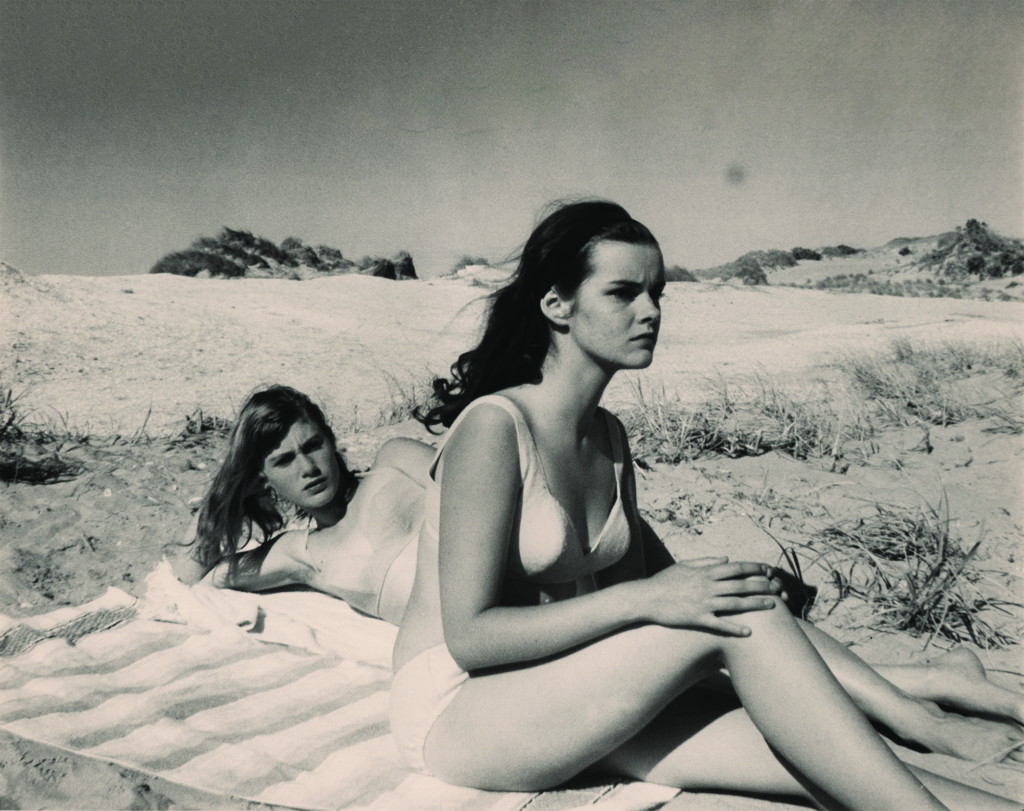
If Anne’s narrative follows a relatively linear trajectory, charting an unfolding summer romance and culminating in the loss of her virginity, Peter’s psychic journey is considerably more labyrinthine. He is first mentioned in a diary entry that Anne is seen writing in the film’s opening sequence; immediately afterwards, we see him injured in the accident. His story is subsequently told through his memories and dreams, mostly consisting of a series of transitory encounters with women. Anywhere he ends up – a party; a downstairs table-tennis club; a theatre; a bedroom; the shell of a ruined mansion – seems to offer only confusing and overwhelming sensory experiences, moving him neither forwards nor backwards. His ultimate destination is the beach, where so much of Anne’s story also takes place – except this place where land and water meet is, for him, one not of nascent desire but of death.
These two interwoven narratives are at times punctuated by montages of lapping water, drifting clouds and treetops, all set to an eerily atonal score by composer Richard Meale. There are some extraordinary shots contained within these passages, making particular use of techniques such as multiple exposure and negative film, and they culminate in a remarkable penultimate sequence: an extended montage of photographs, superimpositions, snatches of previous scenes and studies of various minor characters’ faces. Two particularly pregnant images bring this sequence to a close: a Meshes-like shot of Adams’ forearm reaching upwards in a forest; and the shadow of O’Brien’s face superimposed over a doorway surrounded by foliage. The latter fades into a long shot of Anne and Shawn walking through the dunes before – like Thomas (David Hemmings) in the final scene of Blow-Up (Michelangelo Antonioni, 1966) – vanishing into thin air.
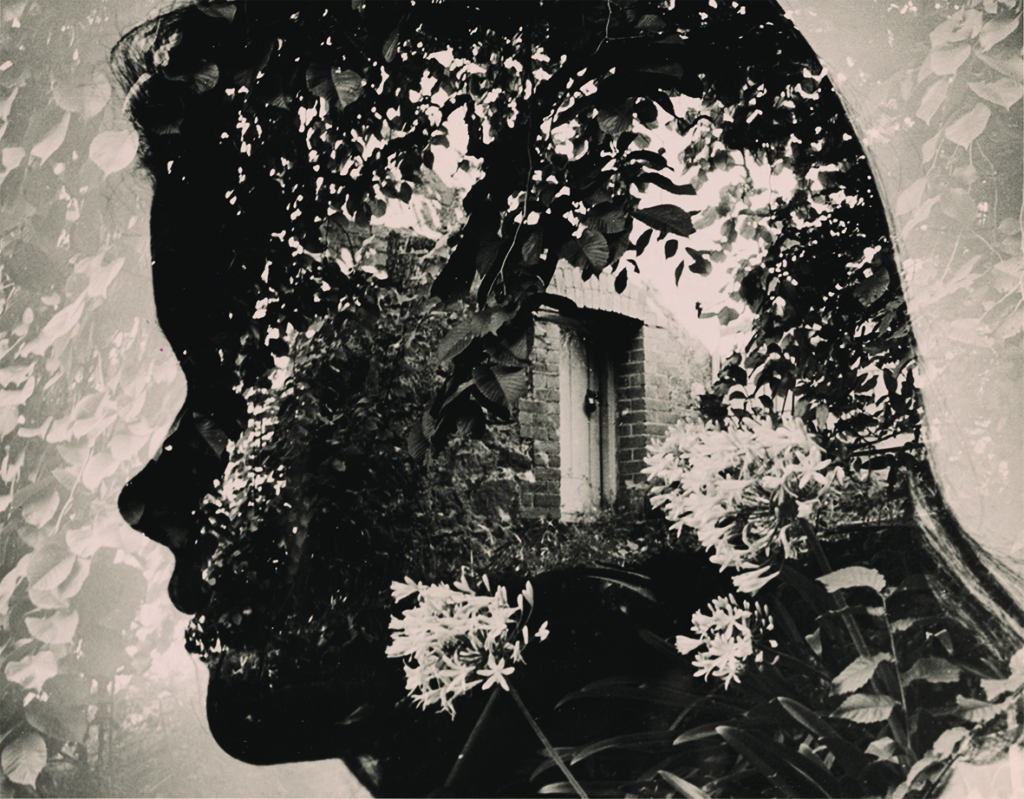
Decoding dreams
As its history suggests, Time in Summer is something of a Frankenstein’s monster, its cobbled-together creation not unlike that of Inland Empire (Lynch, 2006).[21]A key element that Lynch worked into this film was re-used footage from his 2002 web series Rabbits. See Colin Marshall, ‘David Lynch Made a Disturbing Web Sitcom Called Rabbits: It’s Now Used by Psychologists to Induce a Sense of Existential Crisis in Research Subjects’, Open Culture, 30 May 2018, <https://www.openculture.com/2018/05/david-lynch-made-a-disturbing-web-sitcom-called-rabbits.html>, accessed 31 May 2022. This may seem an obvious explanation for its apparent incoherence, but there is an intelligence animating the film’s construction that becomes clearer on subsequent viewings.
The dream has created an erotic yearning, which Anne is seemingly fated to act on … The real world becomes a mirror of the dream world, rather than the other way around.
Time in Summer is a film of oppositions, many of which are contained in the pairing of these two plotlines. Here, as in Marcel Hanoun and Catherine Binet’s Spring (1970), a young female character’s sexual self-discovery runs parallel with a man’s death; the beginning sits alongside the end, Eros with Thanatos. While Anne’s climactic sexual encounter is not shown on screen – it is, in fact, broken up by Peter’s beach-set dream of death – an earlier moment of sexual awakening is represented more vividly. As Anne lies in bed in the early hours of the morning, images of herself soaking and running along the sand naked play through her mind; she responds to this premonition by venturing to the beach, stripping off and running into the water. The dream has created an erotic yearning, which she is seemingly fated to act on. As such, this sequence offers another opposition: as in Reflections, the real world becomes a mirror of the dream world, rather than the other way around.
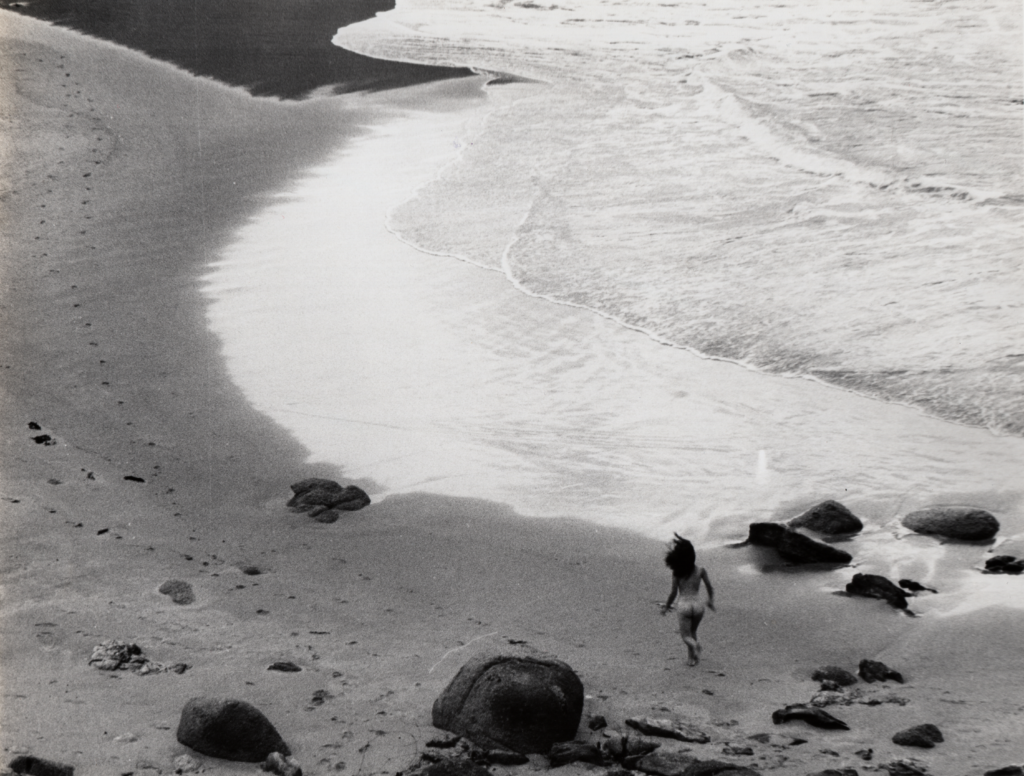
What is real as opposed to dreamed is ambiguous in Time in Summer, and Anne’s comparatively ‘straight’ narrative is slipperier than it initially seems. When she and Helena first explore the house that the boys have fled to, Anne’s voiceover describes the incursion of the dream world into the real one: ‘Nightmares rushed at me. I seemed to get mixed up with other people’s dreams.’ And elements of her own story seem unreliable, too; much as in Jacques Rivette’s Out 1 (1971) and Gang of Four (1989), the criminal conspiracy that she uncovers becomes more incomprehensible the closer she gets to it, to the extent that it seems unclear whether it, too, is a figment of hyperactive imagination – a longing to find logic and meaning where there is none.
A further symbolic element in the film is the act of looking. Anne, in particular, is positioned more as voyeuristic observer than active participant; we see her watching Shawn and his friends through a telescope, then binoculars, then a window. And it is strange, too, that the film’s MacGuffin both resembles a camera – a device used to passively observe events – and has the capacity to harm, either by blinding those who look into its gaze or setting objects aflame.
When experiencing the film for the first time, viewers are likely to be preoccupied with the difficulty of not only grasping its narrative threads but also identifying its various characters, a considerable number of whom come and go within the film’s short running time and sometimes look alike. It is, thus, a film that benefits from preparation and demands revisiting, something that its extremely infrequent screenings and absence from home video and even internet back channels have hitherto rendered effectively impossible.
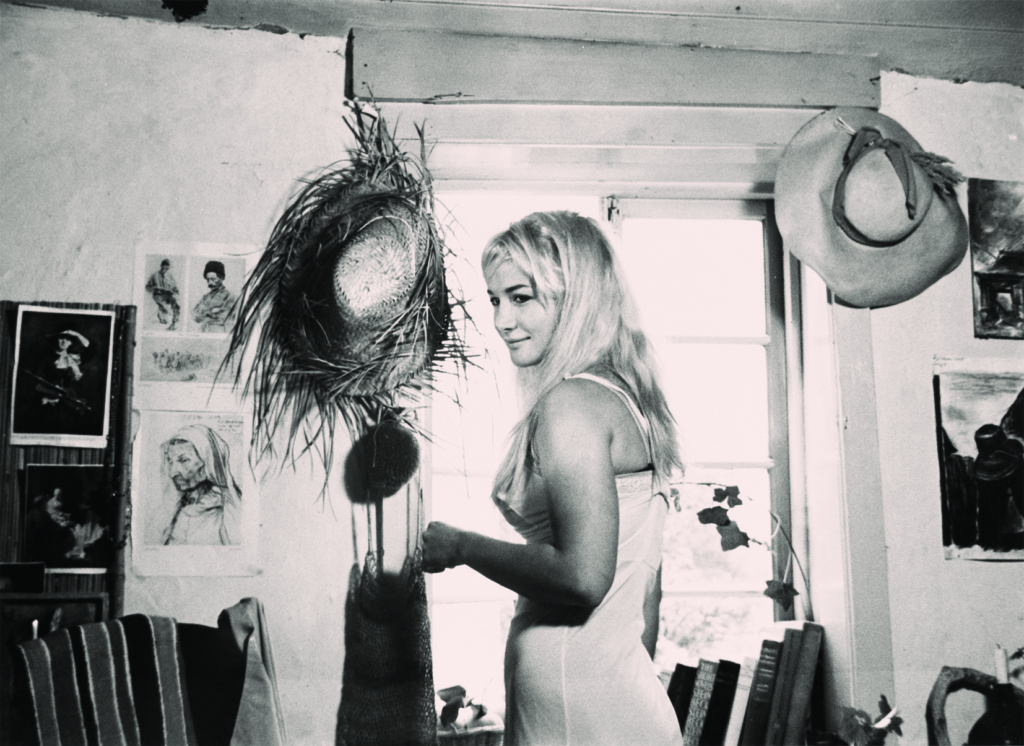
The cinematic genre that most insistently demands – and, arguably, rewards – such repeated engagement is that of the ‘puzzle film’. These are works that, in the words of film scholar Warren Buckland, ‘embrace non-linearity, time loops, and fragmented spatio-temporal reality’, and that ‘blur the boundaries between different levels of reality, are riddled with gaps, deception, labyrinthine structures, ambiguity, and overt coincidences’.[22]Warren Buckland, ‘Introduction: Puzzle Plots’, in Buckland (ed.), Puzzle Films: Complex Storytelling in Contemporary Cinema, Wiley-Blackwell, Malden, MA & Chichester, UK, 2009, p. 6. As such, it is clearly a grouping – notable examples of which include Last Year at Marienbad, Mulholland Drive, Blow-Up, Persona, Rashomon (Akira Kurosawa, 1950) and Donnie Darko (Richard Kelly, 2001)[23]Film scholars Miklós Kiss and Steven Willemsen go further by categorising some of these titles as ‘impossible puzzle films’, describing them as ‘narrative movies that are characterised by pervasive paradoxes, uncertainties, incongruities and ambiguities in the narration, and which, as a consequence, tend to elicit a state of ongoing cognitive confusion throughout the viewing experience’. Kiss & Willemsen, Impossible Puzzle Films: A Cognitive Approach to Contemporary Complex Cinema, Edinburgh University Press, Edinburgh, 2017, p. 6. Emphasis added. – within which Time in Summer belongs. These are films that are ripe for interpretation and analysis, and have accordingly long been staples of undergraduate film studies courses. While most would agree that Time in Summer is a lesser artistic achievement than much of that cohort, it seems reasonable to surmise that perceptions of the film and its place in Australian cinema would be very different had there been more willingness – and capacity – to unravel its mysteries.
An unfavourable climate
Despite its art-film credentials, much of the immediate reaction toTime in Summer was sensationalist in nature; as one contemporaneous report put it, ‘the nude scene, where [O’Brien] is seen with her back to the camera at the beach, sparked a certain amount of publicity’.[24]‘Time in Summer for S.A. Soon’, TV-Guide, Nightlife edition, 22 September 1968, p. 22. Elsewhere, the tabloid headline ‘“Beach Scandal”: Actress Tells’ accompanied a boudoir shot of O’Brien in flyers advertising the 15 April 1969 edition of Sydney’s Daily Mirror. Perhaps as a result of this attention, the film received no fewer than four sold-out screenings at the Festival of Arts across consecutive weekends.
The critics who covered Time in Summer were somewhat more reserved, although generally offered at least measured praise. Following its premiere, Mary Palazzo of The News described the film as a ‘masterpiece of artistry’,[25]Something that seems to be unanimously agreed on by viewers of Time in Summer is the beauty of its images; as producer Colin Reck puts it, ‘There is so much to revel in and learn from and [to] inspire anyone who uses a camera, still or moving.’ Reck, quoted in ‘Time in Summer: An Ian Davidson Retrospective’, media release, Media Resource Centre, 1998. but conceded that it was nonetheless ‘difficult to follow’;[26]Mary Palazzo, ‘New Films in Town’, The News, 18 March 1968. The Advertiser’s Mary Armitage referred to Davidson’s camerawork as ‘the most imaginative I have ever seen in an Australian-made film’ and even reminiscent of The Seventh Seal (Bergman, 1957);[27]Mary Armitage, ‘New Films: Produced in S.A.’, The Advertiser, 18 March 1968, p. 13. and an unsigned review in the short-lived Adelaide film journal Cinesa Bi-Monthly declared that the cinematography ‘shows a high degree of ingenuity and technical expertise’, though added the amusing caveat that ‘there are times when it is […] too exciting’. After noting some of the film’s other shortcomings, this last piece concluded by opining that ‘Arkaba Films deserve[s] a successful and prosperous future’.[28]‘Time in Summer’, Cinesa Bi-Monthly, vol. 1, no. 1, March 1968, pp. 12–3.
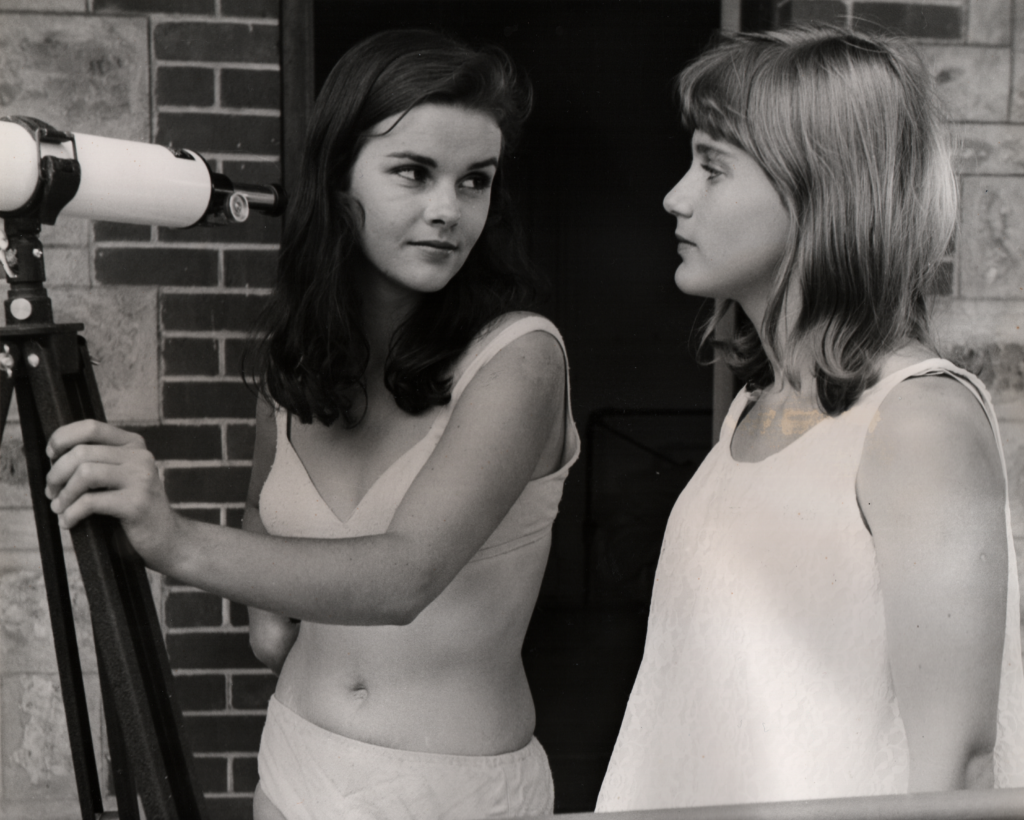
Sadly, no such future was forthcoming. Following its Berlin appearance, Time in Summer was not picked up for local or international distribution,[29]Davidson relates that there was some interest from Svensk Filmindustri, but that they were only willing to distribute the film on the proviso that it be included in a package of Australian work; unfortunately, as he puts it, no such ‘supply of films’ existed. Davidson, ‘Influences in My Life’, op. cit., pp. 6–7. and a shorter, hour-long cut[30]This version is quite different from the original cut: the crucial narrative context offered by Anne’s diary entry is lost through the omission of that prologue, and several of the ensuing scenes are jammed into an even more opaque extended pre-credits sequence. Although these changes are mostly to the detriment of this version of the film, one arguable improvement is the omission of the final confrontation between Anne and a jealous Helena, which is one of the weaker sequences in the longer cut. prepared by Davidson for television was never screened. While Davidson penned several scripts in the years that followed, these remained unfunded and unrealised. Davidson would go on to shoot one more short, the documentary The Last Coastline: A Journey to Eyre Peninsula (Turney-Smith, 1974), and work as an assistant on the early Cox feature Kostas (1979) before walking away from the film industry altogether; he passed away in 2000. Dutkiewicz, meanwhile, devoted much of the rest of his working life to botanical illustration, and died in 2008.[31]Hoskin, op. cit.
It is unsurprising that a work as challenging as Time in Summer – made ‘primarily with the European market in mind, and not as a general-appeal box office attraction’[32]‘Time in Summer for S.A. Soon’, op. cit., p. 22. – had little hope of breaking into an Australian cinematic landscape dominated by high-budget Hollywood productions, with its smaller arthouse market already catered to by big-name European auteurs like Antonioni and Bergman. And it is interesting to observe how little has changed on this front over half-a-century later: while locally produced box-office hits have broken through over the years, the concept of a respected and distinctive Australian cinema with space for formal experimentation is hardly any less fraught today.[33]See Glenda Hambly, ‘Out of the Frying Pan: Screen Australia and the Producer Offset’, Metro, no. 209, 2021, pp. 124–8. Some moderate international festival success stories aside, it is hard to think of any Australian auteur in recent times who, in this country, has been considered on par with the great directors of, for instance, France, Iran, Mexico or South Korea.
Where the film is at its best is when it is most unmoored from plot, and simply allows its stream of images to take over – and, in these moments, it becomes something genuinely transcendent.
If Australian cinema has sometimes been characterised by self-consciousness, then Time in Summer – a film conspicuously inspired by critically acclaimed work from abroad – was no exception. And there is no question that it falls short of the European art films that it sought to emulate:[34]Davidson specifically listed Deren, Eisenstein, Germaine Dulac, Jean Vigo and Jean Cocteau as influences. See Donaldson, op. cit. the flatly delivered post-synched dialogue[35]This shortcoming was a direct result of then-unwieldy technology. Davidson recounts that, at the time, ‘voice recording was always a nightmare when filming features in Australia’, and that, during the shoot, he and Dutkiewicz ‘were constantly having troubles with wind […] and other extraneous noises’, eventually necessitating a studio dub. Ian Davidson, letter to David Donaldson, 25 February 1998. is at times unintentionally comical; the film drags during the crime-plot sequences; and some experimental devices are less successful than others (for instance, the bursts of ‘flashback’ voiceover during the scene in which Anne and Shawn walk along the beach come across as particularly amateurish). Where the film is at its best is when it is most unmoored from plot, and simply allows its stream of images to take over – and, in these moments, it becomes something genuinely transcendent. For these passages alone, Time in Summer should be considered a major work of Australian cinema.
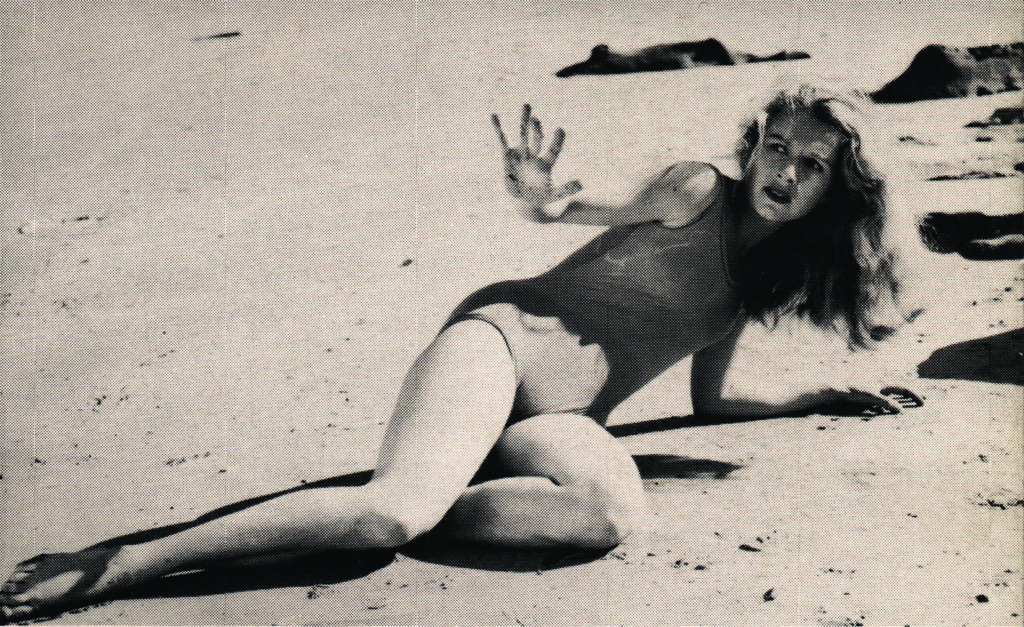
In a late sequence that concludes Peter’s dream narrative, he emerges from a sand dune to see an act of attempted violence playing out on the beach below: the ballerina (Lorraine Irving) he previously saw on stage is being chased by a car, the same one that crashed in the prologue – except, here, it is driven by the dark-haired femme fatale (Ann Holzner) from the ballet sequence. The dancer evades being run down, and the car crashes once more, spilling out its driver. As Peter rushes to assist, the dancer creeps up behind him and places her hands over his eyes, plunging him into darkness. Death has caught up with him at last.
Time in Summer’s fleeting appearance and lengthy disappearance can be treated as its own metaphor for death and rebirth. The film emerged as an early (too early) florescence during the Australian film industry’s winter hibernation, yet also marked the end of its filmmakers’ brief careers – and, through its failure, also signalled the closing off of a potential direction in mainstream Australian filmmaking. If an Australian avant-garde sensibility ever emerges from its currently marginal position in the nation’s screen culture, perhaps this imperfect but nonetheless remarkable film can be rediscovered as an early predecessor – and a courageous shot in the dark.
The author would like to thank Michelle Carey, Jill Davidson, David Donaldson, Adam Dutkiewicz, Juergen Kellermann, Idris Kellermann Williams and Zsuzsi Szucs for their generous and indispensable assistance.
Endnotes
| 1 | Time in Summer was screened as part of a strand showcasing work from less cinematically established nations, known as Filmschau der Länder, or Film Show of the Countries. It appears that the only impediment to the film being selected for the official competition was the lateness of its submission: in a letter to executive producer Bryan Glennon on 7 June 1968, festival director Alfred Bauer stated that the selection committee ‘was very much impressed by the film and considers it a very fine production’ but were unable to include it in the competition ‘because the completed print had arrived a little late’. He nonetheless encouraged Glennon to submit the film in the sidebar and invited him, Dutkiewicz and the three main cast members to attend the festival (only O’Brien and Glennon ended up making the trip). Alfred Bauer, letter to Bryan Glennon, 7 June 1968. |
|---|---|
| 2 | For more on Clay and the work of Mangiamele, see Gino Moliterno, ‘Giorgio Mangiamele: Visionary of the Australian Screen’, Metro, no. 170, Spring 2011, pp. 74–9. |
| 3 | For more on this, see Peter Galvin, ‘At the Threshold of Revival: Australian Cinema and the Moment of 2000 Weeks’, Metro, no. 209, 2021, pp. 102–9 |
| 4 | Space does not permit a thorough overview of the history of Australian avant-garde filmmaking in this article, but suffice it to say the movement was still in its early stages in the 1960s, and mostly concentrated around Sydney’s Ubu Films collective. A key member of that group, Albie Thoms, describes Davidson and Dutkiewicz, along with Stan Ostoja-Kotkowski and Frank Eidlitz, as ‘the major avant-garde filmers outside the Ubu group in the mid-60s’. That these pioneering directors were mostly central or eastern European immigrants is surely no coincidence, and worthy of further discussion. See Thoms, ‘The Australian Avant-Garde’, in Albert Moran & Tom O’Regan, An Australian Film Reader, Currency Press, Paddington, NSW, 1985, p. 286. |
| 5 | Time in Summer’s most recent public screening, to this writer’s knowledge, was in June 1998 at a one-off event in Adelaide organised by Sydney Film Festival founder David Donaldson and the South Australian Media Resource Centre. Another recorded programming of the film was in Sydney at a series of screenings run by Ubu Films in April 1969; publicity material for the event talked up the film’s importance as a rare Australian-produced feature, and noted that it had been overlooked for commercial distribution. See Peter Mudie, Ubu Films: Sydney Underground Movies 1965–1970, University of New South Wales Press, Sydney, 1997, p. 186. |
| 6 | The film is given a single page in each of Australian Film: 1900–1977: A Guide to Feature Film Production and The Oxford Companion to Australian Film. See Andrew Pike & Ross Cooper, ‘Time in Summer’, in Pike & Cooper, Australian Film: 1900–1977: A Guide to Feature Film Production, rev. edn, Oxford University Press, South Melbourne, Vic., 1998 [1980], p. 240; and Ben Goldsmith, ‘Time in Summer’, in Brian McFarlane, Geoff Mayer & Ina Bertrand (eds), The Oxford Companion to Australian Film, Oxford University Press, South Melbourne, Vic., 1999, p. 497. |
| 7 | This is reflected in the opening credits, which give Davidson the credit for Time in Summer’s ‘film form’. |
| 8 | See Tony Love, ‘Hooked on Photography’, The Advertiser, 14 October 2000, p. 70. |
| 9 | See Ian Davidson, Art, Theatre and Photography: Remembering Stan Ostoja-Kotkowski (1922–1994), self-published manuscript, Adelaide, 1999. |
| 10 | Ian Davidson, quoted in Arthur Cantrill, ‘Adelaide – Experimental Film in the 1950s and ’60s’, Cantrills Filmnotes, nos 81/82, June 1996, p. 54. |
| 11 | Adam Dutkiewicz, Ludwik Dutkiewicz: Adventures in Art – Paintings, Graphics, Photographs & Films, Moon Arrow Press, Norwood, SA, 2009, p. 18. |
| 12 | ibid., p. 24. |
| 13 | Davidson refers to the non-release of Cobweb on a Parachute as ‘a tragedy’, and states that, had the film been shown, ‘it would have put Australia uniquely on the map of world film-makers’. Ian Davidson, ‘Influences in My Life’, document held at the University of Adelaide, 26 June 2000, p. 7. |
| 14 | David Donaldson, notes from interview with Ian Davidson, 1997. |
| 15 | Davidson, quoted in Cantrill, op. cit., p. 55. |
| 16 | Ludwik Dutkiewicz, quoted in ‘Film Prize Is Boost to “School”’, The Advertiser, 18 May 1966, cited in Adam Dutkiewicz, op. cit., p. 58. |
| 17 | ‘Film Prize Is Boost to “School”’, ibid. |
| 18 | See Cheryl Hoskin, ‘Biographical Note’, in ‘Ludwik Dutkiewicz (1921–2008): Papers’, November 2020, <https://www.adelaide.edu.au/library/special/mss/dutkiewicz/>, accessed 30 May 2022. |
| 19 | Davidson, ‘Influences in My Life’, op. cit., p. 6. |
| 20 | Anne’s opening monologue, heard over a close-up of her hand writing the same words in a diary. |
| 21 | A key element that Lynch worked into this film was re-used footage from his 2002 web series Rabbits. See Colin Marshall, ‘David Lynch Made a Disturbing Web Sitcom Called Rabbits: It’s Now Used by Psychologists to Induce a Sense of Existential Crisis in Research Subjects’, Open Culture, 30 May 2018, <https://www.openculture.com/2018/05/david-lynch-made-a-disturbing-web-sitcom-called-rabbits.html>, accessed 31 May 2022. |
| 22 | Warren Buckland, ‘Introduction: Puzzle Plots’, in Buckland (ed.), Puzzle Films: Complex Storytelling in Contemporary Cinema, Wiley-Blackwell, Malden, MA & Chichester, UK, 2009, p. 6. |
| 23 | Film scholars Miklós Kiss and Steven Willemsen go further by categorising some of these titles as ‘impossible puzzle films’, describing them as ‘narrative movies that are characterised by pervasive paradoxes, uncertainties, incongruities and ambiguities in the narration, and which, as a consequence, tend to elicit a state of ongoing cognitive confusion throughout the viewing experience’. Kiss & Willemsen, Impossible Puzzle Films: A Cognitive Approach to Contemporary Complex Cinema, Edinburgh University Press, Edinburgh, 2017, p. 6. Emphasis added. |
| 24 | ‘Time in Summer for S.A. Soon’, TV-Guide, Nightlife edition, 22 September 1968, p. 22. Elsewhere, the tabloid headline ‘“Beach Scandal”: Actress Tells’ accompanied a boudoir shot of O’Brien in flyers advertising the 15 April 1969 edition of Sydney’s Daily Mirror. |
| 25 | Something that seems to be unanimously agreed on by viewers of Time in Summer is the beauty of its images; as producer Colin Reck puts it, ‘There is so much to revel in and learn from and [to] inspire anyone who uses a camera, still or moving.’ Reck, quoted in ‘Time in Summer: An Ian Davidson Retrospective’, media release, Media Resource Centre, 1998. |
| 26 | Mary Palazzo, ‘New Films in Town’, The News, 18 March 1968. |
| 27 | Mary Armitage, ‘New Films: Produced in S.A.’, The Advertiser, 18 March 1968, p. 13. |
| 28 | ‘Time in Summer’, Cinesa Bi-Monthly, vol. 1, no. 1, March 1968, pp. 12–3. |
| 29 | Davidson relates that there was some interest from Svensk Filmindustri, but that they were only willing to distribute the film on the proviso that it be included in a package of Australian work; unfortunately, as he puts it, no such ‘supply of films’ existed. Davidson, ‘Influences in My Life’, op. cit., pp. 6–7. |
| 30 | This version is quite different from the original cut: the crucial narrative context offered by Anne’s diary entry is lost through the omission of that prologue, and several of the ensuing scenes are jammed into an even more opaque extended pre-credits sequence. Although these changes are mostly to the detriment of this version of the film, one arguable improvement is the omission of the final confrontation between Anne and a jealous Helena, which is one of the weaker sequences in the longer cut. |
| 31 | Hoskin, op. cit. |
| 32 | ‘Time in Summer for S.A. Soon’, op. cit., p. 22. |
| 33 | See Glenda Hambly, ‘Out of the Frying Pan: Screen Australia and the Producer Offset’, Metro, no. 209, 2021, pp. 124–8. |
| 34 | Davidson specifically listed Deren, Eisenstein, Germaine Dulac, Jean Vigo and Jean Cocteau as influences. See Donaldson, op. cit. |
| 35 | This shortcoming was a direct result of then-unwieldy technology. Davidson recounts that, at the time, ‘voice recording was always a nightmare when filming features in Australia’, and that, during the shoot, he and Dutkiewicz ‘were constantly having troubles with wind […] and other extraneous noises’, eventually necessitating a studio dub. Ian Davidson, letter to David Donaldson, 25 February 1998. |
